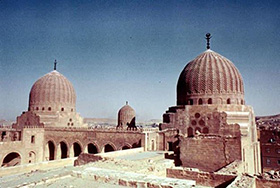Islamic Period and Modern Times Monuments
- Neolithic Period: 4500-3000 BCE
- Early Dynastic: 3000-2650 BCE
- Old Kingdom: 2650-2150 BCE
- 1st Intermediate Period: 2150-2040 BCE
- Middle Kingdom: 2040-1640 BCE
- 2nd Intermediate Period: 1640-1550 BCE
- New Kingdom: 1550-1070 BCE
- 3rd Intermediate Period: 1070-712 BCE
- Saite and Late Periods: 712-332 BCE
- Greco-Roman Period: 332 BCE-642 CE
- Coptic Period: 395-642 CE
- Islamic Period and Modern Times: 642 CE-Today
- Neolithic Period: 4500-3000 BCE
- Early Dynastic: 3000-2650 BCE
- Old Kingdom: 2650-2150 BCE
- 1st Intermediate Period: 2150-2040 BCE
- Middle Kingdom: 2040-1640 BCE
- 2nd Intermediate Period: 1640-1550 BCE
- New Kingdom: 1550-1070 BCE
- 3rd Intermediate Period: 1070-712 BCE
- Saite and Late Periods: 712-332 BCE
- Greco-Roman Period: 332 BCE-642 CE
- Coptic Period: 395-642 CE
- Islamic Period and Modern Times: 642 CE-Today
The Khanqah & Mausoleum of Sultan Faraj Ibn Barquq
Begun 1398
This complex in the Northern Cemetery of Cairo is one of the largest and best-preserved monuments from the era of Sufi Mamluk rulers in Egypt.
Sultan Faraj, having ascended to the throne at the age of 10, ordered a funerary complex built as a tribute to his father, Sultan Barquq, in 1398. The site’s design grew to also include schools, sleeping quarters, a mosque, baths, grain mills, and a market. Some scholars posit that an additional purpose of the site was an attempt to urbanize the desert, one of the region’s first attempts at that.
The site is particularly famous for having the two largest and oldest chevron-carved stone domes in Cairo. The square complex is unusual in having a symmetrical pair of domes, minarets, and other buildings laid out in a bilateral fashion. There are two of everything so men and women can be buried, pray, live, and study separately.

http://web.mit.edu/4.615/www/handout14.htm
http://www.discoverislamicart.org/database_item.php?id=monument;isl;eg;mon01;26;en

